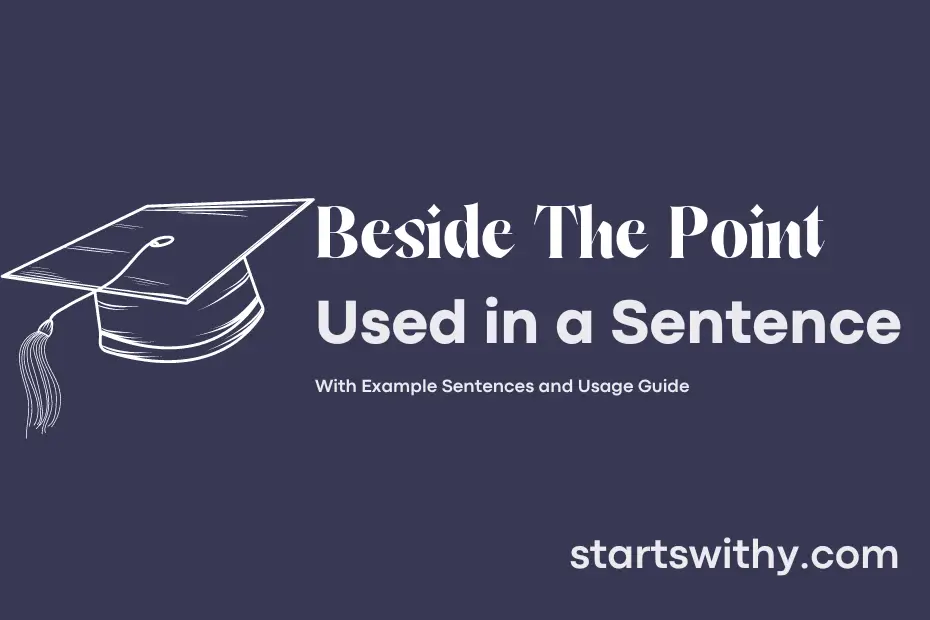Have you ever heard the phrase “beside the point” and wondered what it means? This common expression is used to indicate that something being discussed or considered is not relevant to the main issue at hand.
When someone says that a comment or argument is beside the point, they are essentially saying that it is off-topic or not important in the context of the conversation or situation. This phrase is often used to redirect focus back to the main topic or to dismiss irrelevant details.
7 Examples Of Beside The Point Used In a Sentence For Kids
- The color of your shoes is beside the point.
- The type of pencil you use is beside the point.
- Whether you like bananas or not is beside the point.
- Your best friend’s favorite color is beside the point.
- The number of buttons on your shirt is beside the point.
- How tall you are is beside the point.
- If you prefer bikes or cars is beside the point.
14 Sentences with Beside The Point Examples
- Beside the point, but have you seen the latest viral video on social media?
- I know you’re worried about the deadline, but arguing about who’s responsible is beside the point.
- Beside the point, but did you hear about the new café that opened near campus?
- Your professor’s personal life is beside the point when it comes to grading your assignment.
- I understand you want to party, but our final exams are next week, so that’s beside the point.
- Beside the point of our discussion, but have you checked out the internship opportunities on the college website?
- Let’s focus on the budget for our event; the color scheme is beside the point.
- The number of likes on your social media post is beside the point when it comes to your academic performance.
- I know you’re excited about the concert, but it’s beside the point when we’re discussing our group project.
- Whether you agree with the speaker’s political views is beside the point in this debate.
- Beside the point, but have you decided which elective courses you’re going to take next semester?
- Your roommate’s choice in music is beside the point when they’re not respecting your study time.
- Beside the point of our discussion, but have you seen the amazing sale happening at the bookstore?
- Don’t let the fact that it’s raining today distract you from studying; it’s beside the point.
How To Use Beside The Point in Sentences?
Beside The Point means not relevant to the current topic or situation. When using this phrase in a sentence, it is important to understand its meaning to avoid confusion.
Here is a simple guide on how to correctly use Beside The Point in a sentence:
- Identify a statement or information that is not directly related to the main topic of discussion.
- Introduce the phrase Beside The Point to indicate that the statement is not relevant to the current conversation.
- Place Beside The Point after the irrelevant information to show that it is off-topic.
For example:
– “I know you are excited about the event, but the color of the decorations is beside the point. We need to focus on organizing the program first.”
In this sentence, the phrase Beside The Point indicates that the color of the decorations is not important in the context of organizing the event. It helps to redirect the focus back to the main task at hand.
By following this guide, you can effectively use Beside The Point in a sentence to clarify that something is not relevant to the discussion or situation.
Conclusion
In communication, it is essential to focus on relevant information and avoid getting sidetracked by tangents or irrelevant details. When sentences are made with phrases like “beside the point,” it highlights that the speaker or writer is emphasizing the need to stay on topic and refrain from discussing matters that do not contribute to the main issue at hand. By recognizing and addressing statements that are beside the point, individuals can maintain clarity, coherence, and effectiveness in their conversations and written exchanges.
By being mindful of staying on track and using language that underscores the importance of relevance, we can enhance understanding and promote more productive discussions. Acknowledging when information is beside the point allows for a more efficient exchange of ideas, leading to more effective communication and decision-making. In summary, staying focused on the main subject and avoiding distractions highlighted by phrases like “beside the point” can lead to clearer, more impactful interactions and exchanges of information.



